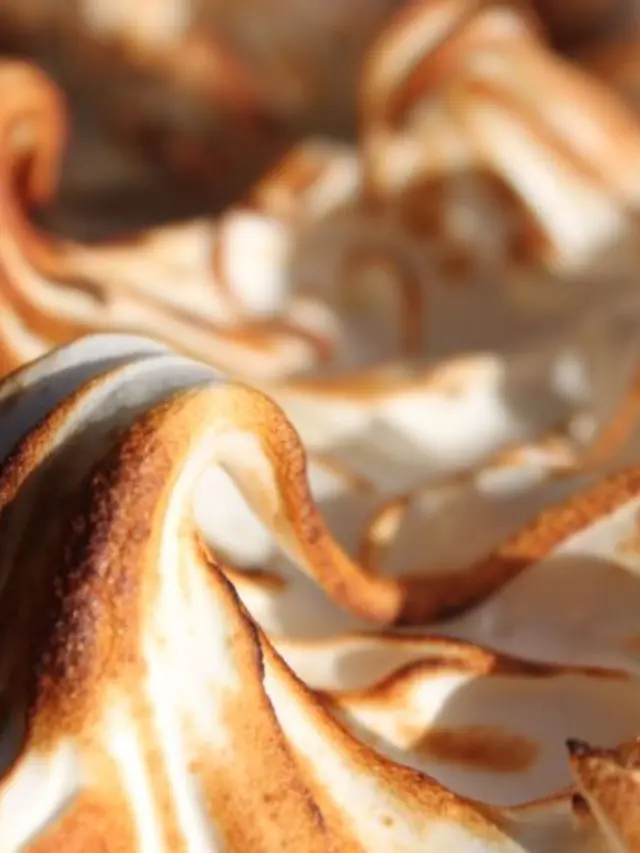A banana meringue inspired by One Hundred Years of Solitude, by Gabriel García Márquez.
Usually, when a book is good we say “you can’t put it down.” This is reserved for books that you miss your subway stop for, that you stay up all night reading, and that you inhale in twenty-four hours and tell all your friends to read. But on very rare occasions I have read a book so good I had to put it down; had to read it slowly, savor it, and come up for air. Of those books, One Hundred Years of Solitude was the most difficult, it took me two false starts and almost a year of off-and-on reading to finally get through it. But there is a truth and vitality to it that reaches into the small, scared, vulnerable, utterly human part of you, grips you buy the soul, and drags into the vibrant depths of its emotion.
Spoiler-Free Summary:
One Hundred Years of Solitude centers around the small, initially isolated provincial town of Macondo (based on Márquez’s childhood home in Aracataca near the coast of Colombia) and primarily on one of its founding families, the Buendías. When people tout a “multi-generational saga” in literary circles these days, they usually mean a story about a woman living with (and generally despising) her own mother and daughter. When Márquez does a multi-generational epic, it’s seven god damn generations of the same weird, slightly intermarried family. Characters (whether born into or bound to the family) come and go, living full lives, deep and wide, with unusual beginnings and unexpected ends. In a family tree rife with confusingly similar names, Márquez explores each family member’s passions, petty dysfunctions, talents, failures, and sexual quirks. A few others – notably mistresses of young, horny Buendía boys and other love interests – also orbit the nuclear family as permanent fixtures. Additionally, the lush jungle setting, rich plot, and heartbreakingly gorgeous aesthetic moments of the book are all heavily influenced by the flavor of magical realism and a light, tingling sense of the supernatural.

Notes From The Piebrary:
Márquez was one of the founding fathers of magical realism in the mid-20th century, building on the work of Argentinian writer Jorge Luis Borges. As a genre, magical realism is exactly what it sounds like: stories that take place in a realistic setting or tackle real issues, but do so with an element of the fantastic or uncanny. This could be as subtly unusual as an old woman being so used to the layout of her house that her family doesn’t realize she’s gone blind, or as actively fantastic as a shipwreck in the middle of the jungle and the blood of a dead son running in a thin stream through the town to stop at his mother’s feet. It’s a distorted lens through which we can view the inexplicable and give it context.
When I say this book is dense, I mean reading it feels like a kind of drowning. The prose is so thick that to me it has the closeness of a summer day; you can feel yourself choking on the humidity, feel the grit of Macondo sticking to the back of your neck, and all you want to do is lie on the tile floor, eat a banana, and sweat. Sometimes it would remind me of my grandfather, I thought he would appreciate these people and the way they could be weary and hopeful, wise and naive, all at the same time. He may not have liked all of them, but he could respect them. More than once I found myself crying for no apparent reason.
Parsing This Pie:
I’m fully aware that I could never in a million years do this book justice in a single pie. Do you know what I really wanted to do? I wanted to get a tiny paint brush or toothpick and draw brightly colored animals – like the confections Ursula Buendía makes – into the creamy meringue. I sad down in front of it with a little pallet of food coloring and the blank canvas of pie in front of me and I just couldn’t do it. It wasn’t that I was at a loss, I just had so many ideas and not enough talent or means to execute them. Should I draw the cock-fighting roosters in blue, green, and red? Should I draw the yellow butterflies and black scorpions that circle Meme as she waits, naked in the candlelit bathroom? The livestock from the raffle in adorable little caricature? I agonized, growing more and more frustrated, afraid to touch toothpick to meringue. Finally, overwhelmed, I address the problem as best I knew how and just torched the damn thing and was done with it.
The few meager metaphors I present you with are these: banana custard for the banana factory that is both a blessing and a curse on the town, and the fact that it is a frozen pie, in honor of the day Colonel Aureliano Buendía’s father takes him to discover ice. The meringue? There’s probably something sexually depraved going on there, but I’ll let you imagine that for yourself.
Recipe:
(Custard and meringue adapted from The Hoosier Mama Book of Pie)
Crust:
-1 cup flour
-1/3 cup butter
-3-4 tbs water
Custard:
-3 ripe bananas (unpeeled)
-1/2 tsp nutmeg
-2 cups heavy cream
-4 large egg yolks
-1 large egg
-2/3 cup granulated sugar
-2 tsp vanilla extract
Meringue:
-2/3 cup egg whites
-1 cup granulated sugar
Preheat oven to 350 degrees Fahrenheit.
Combine crust ingredients into a rough dough, roll out and line pie tin, and blind bake for about 15 minutes until golden brown.
Prick the bananas with a fork, sprinkle liberally with the nutmeg and bake for 25 minutes until brown, greasy, and soft. Mmm. Allow them to cool. Measure out 2/3 cup banana goo and combine with the cream in a small saucepan. Mash with a whisk and cook over medium heat until the mixture is simmering. Remove from heat and allow to steep.
In a medium-sized heat-proof bowl whisk the egg yolks (SAVE THE WHITES!), egg, sugar, and salt together. Pour the banana mixture through a fine mesh strainer in small batches, whisking in thoroughly, and then add the vanilla. Pour the custard into the pie shell and bake for approximately 45 minutes, rotating halfway through. When shaken, the finished custard should jiggle only slightly in the center. Allow to cool and then refrigerate.
For the meringue, bring a saucepan full of water to a boil. Combine 2/3 cup of the leftover egg whites and the sugar in a medium stainless steel bowl and whisk thoroughly. Use the bowl as the top half of a double boiler, heating the egg whites and sugar over the boiling water. Whisk constantly until they reach 165 degrees fahrenheit. Remove from heat and continue to mix with a hand or stand mixer until the bowl is cool to the touch. Immediately spread the meringue on the banana custard and artfully torch. Return to the refrigerator until ready to serve.
Enjoy in the cool of the house or the heat of the garden, underneath a tree.

